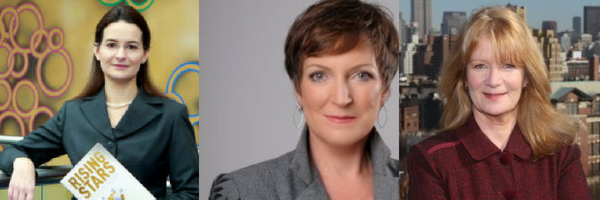3 Women That Every Male Leader Should Know
 Savvy business leaders now know what the research reveals: everyone wins when a company and its leadership achieves gender parity. They also know that to get there, you have to change how you work in partnership with women.
Savvy business leaders now know what the research reveals: everyone wins when a company and its leadership achieves gender parity. They also know that to get there, you have to change how you work in partnership with women.
Three leading women experts are challenging the way we’ve traditionally thought about and addressed this topic. Elisabeth Kelan, PhD, Avivah Wittenberg-Cox, and Barbara Annis think holistically about the requirements of both men and women in the workplace, and their work shows us how parity in the workplace can only achieved when we address the needs and perspectives of both men and women.

Their thought leadership informs my work and provided critical input to my forthcoming book WE: Men, Women and the Decisive Formula for Winning at Work (Wiley, September 2018).
Here are three of the main areas they cover that might influence your leadership and perspective about how men and women work together.
1. Research
Three of the most valuable subjects that Dr. Kelan explores are:
-
The complex relationship between gender, technology and work.
This topic is surprisingly and rarely the subject of deep, mainstream, empirical research. In one of her book Performing Gender at Work, Dr. Kelan explores how technologies are developed and used in different work contexts by men and women.
-
How inclusive male managers support women.
Dr. Kelan shadowed midlevel, male managers at several companies to uncover the behaviors of the most supportive male bosses. She found that the best ones, encouraged women to take so-called “stretch assignments”, spoke about their achievements to colleagues, and put a stop to behaviors that alienated women.
-
Undoing gender.
What happens if gender is no longer a central element of work life? “Doing gender” highlights gender differences while “undoing gender” is about reducing gender differences. One under explored aspect that Dr. Kelan addresses is how men can do, and undo, gender to support or hinder gender equality in the workplace.

2. Companies
Through her gender diversity consultancy, 20-First, Wittenberg-Cox focuses on the role of leaders (not women) to drive equality and results in corporations. Here are few of the positions for which she advocates:
- “We need to continue the momentum of companies focused on getting men skilled at leading across genders. Until we can have an inclusive conversation – with everyone, including men – about existing gender roles, expectations and stereotypes, we are bound to remain locked in them.”
- “Gender equality is not a ‘women’s issue’—it’s a huge political, economic, and social opportunity. It is a massive business issue that more than 75% of corporate CEOs currently put on their agenda of top 10 issues.”
- “It’s time to become gender bilingual. That doesn’t mean we speak two different languages. It means we deeply understand different cultures and build bridges between them to include everyone. It also means replacing women’s networks and other women-branded initiatives with inclusive approaches that unite men and women rather than separating them.”
- “Offices perpetuate the rigid strictures of masculinity. While gender biases and inflexible systems still hold back working mothers, research has found that fathers who take time off to care for their families may be even more harshly penalized at work. Even a short absence results in lower performance evaluations and fewer awards, something that doesn’t happen when men take time off for other, more ‘macho’ reasons (such as taking a vacation or training for a marathon).”
 3. Communication
3. Communication
Annis is the CEO of the Gender Intelligence Group. Her pioneering, transformational solutions don’t seek to eliminate the differences between men and women but instead help them recognize and leverage these differences.
Her two books are Same Words, Different Languages, and Work With Me: The Eight Blind Spots Between Men and Women in Business (co-authored with John Gray). Annis tackles topics that include how to listen effectively, negotiation, and networking, by showing what men think, say, and do, in comparison to what women think, say, and do. She details the misunderstanding and false assumptions by both, and the solutions that don’t overcome the differences but instead, value and leverage them. She even addresses topic like how the use of the word “yes,” and the question “what are you thinking?” means different things to women and men in business conversations.
Annis’ decades of work reveals the false assumptions and myths men and women have of each other. Using many real-world examples, she illuminates the different ways men and women communicate, feel recognized, and express emotion. She expresses empathy both for men—who feel like they have to walk on eggshells around women at work—and for women—who often feel unheard or excluded by men in the workplace.
Thank you Elizabeth Kelan, PhD, Avivah Wittenberg-Cox, and Barbara Annis for your remarkable work and leadership!